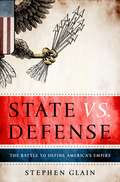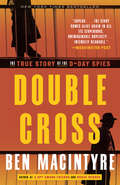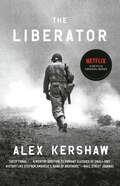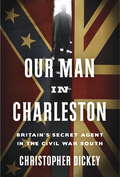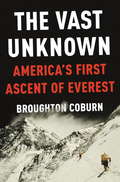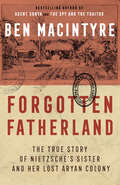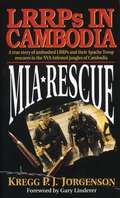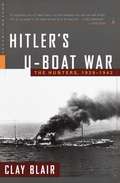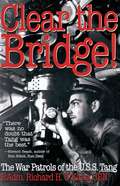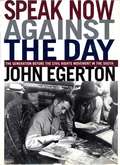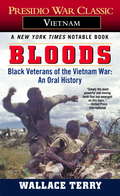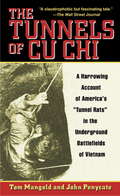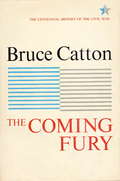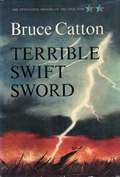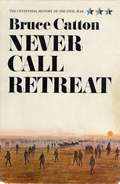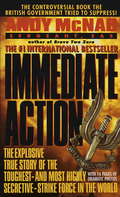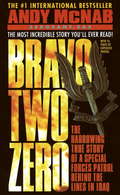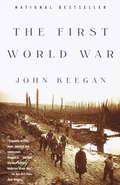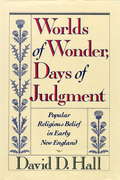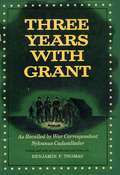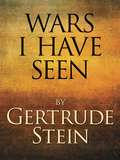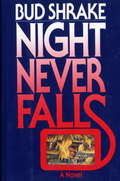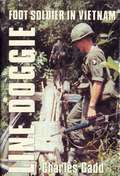- Table View
- List View
State vs. Defense: The Battle to Define America's Empire
by Stephen GlainA masterful account of how sixty years of American militarism created the Cold War, fanned decades of unnecessary conflict, helped to fuel Islamist terror, and threatens to bankrupt the country. For most of the twentieth century, the sword has led before the olive branch in American foreign policy. In eye-opening fashion, State vs. Defense shows how America truly operates as a superpower and explores the constant tension between the diplomats at State and the warriors at Defense. State vs. Defense characterizes all the great figures who crafted American foreign policy, from George Marshall to Robert McNamara to Henry Kissinger to Don Rumsfeld with this underlying theme: America has become increasingly imperial and militaristic. Take, for example, the Pentagon, which as of 2010, acknowledged the concentration of 190,000 troops and 115,000 civilian employees inside 909 military facilities in 46 countries and territories. The price of America's military-base network overseas, along with the expense of its national security state at home, is enormous. The bill comes in at well over $1 trillion. That is equal to nearly 8 percent of GDP and more than 20 percent of the federal budget. (By comparison, China, Russia, Cuba, Iran, and North Korea, the five countries Pentagon planners routinely trot out as conventional threats to the national well-being, have a cumulative security budget of just over $200 billion.) Quietly, gradually--and inevitably, given the weight of its colossal budget and imperial writ--the Pentagon has all but eclipsed the State Department at the center of U.S. foreign policy. In the tradition of classics such as The Wise Men, The Best and the Brightest, and Legacy of Ashes, State vs. Defense explores how and why American leaders succumbed to the sirens of militarism, how the republic has been lost to an empire, and how "the military-industrial complex" that Eisenhower so famously forewarned has set us on a stark path of financial peril.
Double Cross: The True Story of the D-Day Spies
by Ben MacintyreNEW YORK TIMES BESTSELLER • The &“superb [and] intensely readable&” (The Washington Post) untold story of one of the greatest deceptions of World War II and the extraordinary spies who achieved it—from the bestselling author of Prisoners of the Castle &“Not since Ian Fleming and John le Carré has a spy writer so captivated readers.&”—The Hollywood Reporter On June 6, 1944, 150,000 Allied troops landed on the beaches of Normandy and suffered an astonishingly low rate of casualties. A stunning military achievement, it was also a masterpiece of trickery. Operation Fortitude, which protected and enabled the invasion, and the Double Cross system, which specialized in turning German spies into double agents, tricked the Nazis into believing that the Allied attacks would come in Calais and Norway rather than Normandy. It was the most sophisticated and successful deception operation ever carried out, ensuring Allied victory at the most pivotal moment in the war. This epic event has never before been told from the perspective of the key individuals in the Double Cross system, until now. These include its director (a brilliant, urbane intelligence officer), a colorful assortment of MI5 handlers (as well as their counterparts in Nazi intelligence), and the five spies who formed Double Cross&’s nucleus: a dashing Serbian playboy, a Polish fighter-pilot, a bisexual Peruvian party girl, a deeply eccentric Spaniard, and a volatile Frenchwoman. Together they made up one of the oddest and most brilliant military units ever assembled. With the same depth of research, eye for the absurd, and masterful storytelling that have made Ben Macintyre an international bestseller, Double Cross is a captivating narrative of the spies who wove a web so intricate it ensnared Hitler&’s army and carried thousands of D-Day troops across the Channel in safety.
The Liberator: One World War II Soldier's 500-Day Odyssey from the Beaches of Sicily to the Gates of Dachau
by Alex KershawThe untold story of the bloodiest and most dramatic march to victory of the Second World War—now a Netflix original series starring Jose Miguel Vasquez, Bryan Hibbard, and Bradley James &“Exceptional . . . worthy addition to vibrant classics of small-unit history like Stephen Ambrose&’s Band of Brothers.&”—Wall Street Journal Written with Alex Kershaw's trademark narrative drive and vivid immediacy, The Liberator traces the remarkable battlefield journey of maverick U.S. Army officer Felix Sparks through the Allied liberation of Europe—from the first landing in Italy to the final death throes of the Third Reich.Over five hundred bloody days, Sparks and his infantry unit battled from the beaches of Sicily through the mountains of Italy and France, ultimately enduring bitter and desperate winter combat against the die-hard SS on the Fatherland's borders. Having miraculously survived the long, bloody march across Europe, Sparks was selected to lead a final charge to Bavaria, where he and his men experienced some of the most intense street fighting suffered by Americans in World War II.And when he finally arrived at the gates of Dachau, Sparks confronted scenes that robbed the mind of reason—and put his humanity to the ultimate test.
Our Man in Charleston: Britain's Secret Agent in the Civil War South
by Christopher DickeyBetween the Confederacy and recognition by Great Britain stood one unlikely Englishman who hated the slave trade. His actions helped determine the fate of a nation. When Robert Bunch arrived in Charleston to take up the post of British consul in 1853, he was young and full of ambition, but even he couldn't have imagined the incredible role he would play in the history-making events to unfold. In an age when diplomats often were spies, Bunch's job included sending intelligence back to the British government in London. Yet as the United States threatened to erupt into Civil War, Bunch found himself plunged into a double life, settling into an amiable routine with his slavery-loving neighbors on the one hand, while working furiously to thwart their plans to achieve a new Confederacy. As secession and war approached, the Southern states found themselves in an impossible position. They knew that recognition from Great Britain would be essential to the survival of the Confederacy, and also that such recognition was likely to be withheld if the South reopened the Atlantic slave trade. But as Bunch meticulously noted from his perch in Charleston, secession's red-hot epicenter, that trade was growing. And as Southern leaders continued to dissemble publicly about their intentions, Bunch sent dispatch after secret dispatch back to the Foreign Office warning of the truth--that economic survival would force the South to import slaves from Africa in massive numbers. When the gears of war finally began to turn, and Bunch was pressed into service on an actual spy mission to make contact with the Confederate government, he found himself in the middle of a fight between the Union and Britain that threatened, in the boast of Secretary of State William Seward, to "wrap the world in flames." In this masterfully told story, Christopher Dickey introduces Consul Bunch as a key figure in the pitched battle between those who wished to reopen the floodgates of bondage and misery, and those who wished to dam the tide forever. Featuring a remarkable cast of diplomats, journalists, senators, and spies, Our Man in Charleston captures the intricate, intense relationship between great powers on the brink of war.From the Hardcover edition.
The Vast Unknown
by Broughton CoburnBy the author of the New York Times bestselling Everest: Mountain Without Mercy, this chronicle of the iconic first American expedition to Mt. Everest in May 1963 - published to coincide with the climb's 50th anniversary - combines riveting adventure, a perceptive analysis of its dark and terrifying historical context, and revelations about a secret mission that followed. In the midst of the Cold War, against the backdrop of the Bay of Pigs fiasco, the space race with the Soviet Union, and the quagmire of the Vietnam War, a band of iconoclastic, independent-minded American mountaineers set off for Mt. Everest, aiming to restore America's confidence and optimism. Their objective is to reach the summit while conducting scientific research, but which route will they take? Might the Chinese, in a public relations coup, have reached the top ahead of them? And what about another American team, led by the grandson of a President, that nearly bagged the peak in a bootleg attempt a year earlier? The Vast Unknown is, on one level, a harrowing, character-driven account of the climb itself and its legendary team of alternately inspiring, troubled, and tragic climbers who suffered injuries, a near mutiny, and death on the mountain. It is also an examination of the profound sway the expedition had over the American consciousness and sense of identity during a time when the country was floundering. And it is an investigation of the expedition's little-known outcome: the selection of a team to plant a CIA surveillance device on the Himalayan peak of Nanda Devi, to spy into China where Defense Intelligence learned that nuclear missile testing was underway.From the Hardcover edition.
Forgotten Fatherland: The True Story of Nietzsche's Sister and Her Lost Aryan Colony
by Ben Macintyre&“A fascinating, provocative, and highly eccentric volume&” (The New York Times) exploring the true story of Elisabeth Nietzsche&’s maniacal attempt to found a utopian colony in the jungles of Paraguay in the late nineteenth century—from the bestselling author of Prisoners of the Castle.In 1886, Elisabeth Nietzsche, the bigoted, imperious sister of the famous philosopher, founded a &“racially pure&” colony in Paraguay with her husband, anti-Semitic agitator Bernhard Förster, and a band of fair-skinned fellow Germans. More than a century later, Ben Macintyre tracked down the survivors of Nueva Germania to discover the remains of this bizarre colony, and found a strange, tight-lipped people, still interbreeding to the point of genetic deterioration. Digging into recently opened German archives, Macintyre unfolds how Elisabeth, who returned to Germany in 1893, grafted her anti-Semitic, nationalist ideas onto her brother&’s philosophy, building a mythic cult around him, and how she later became a mentor to Hitler—her stately funeral in 1935 attended by a tearful Führer. Laced with mordant irony, Macintyre&’s brilliant piece of investigative journalism explores how the Nazis perverted Friedrich Nietzsche&’s ideas to justify their evil deeds, and unearths a rich and disturbing vein of the twentieth century&’s dark history.
MIA Rescue: LRRPs in Cambodia
by Kregg P. Jorgenson"This is an inspiring story of courage and sacrifice--one hell of an exciting true war story!"--Kenn Miller Author of Tiger the Lurp DogOn 17 June 1970, in Mondol Kiri Province, Cambodia, the five men of Long-Range Reconnaissance Patrol (LRRP) Team 5-2 were about to halt for the day. Night was coming, the skies were dark, and so were the men's thoughts--they'd just found freshly dug NVA bunkers inside a scrub-brush tree line and their position was not secure. As they carefully searched for better night lager, they learned the hard way that they had walked into an ambush kill zone: NVA fire quickly downed two men and wounded two others. In minutes, Team 5-2 had been transformed from the hunters to the hunted. They had no radio comms with their headquarters and had just two rifles and fifteen magazines of ammunition.Two men were down, but the team was not out. MIA RESCUE is the story of Team 5-2 and the heroic and ultimately successful attempts to rescue them despite extraordinarily bad weather and an angry and aware enemy. "Seldom can an author stimulate emotions, from the taste of fear to sweaty palms to the feeling of relief when the mission is over, but Jorgenson does and much more. If the reader was never in combat, he will feel like a Nam vet when he finishes this book."--Jerry Boyle Author of Apache SunriseFrom the Paperback edition.
Hitler's U-Boat War
by Clay BlairClay Blair's best-selling naval classic Silent Victory: The U.S. Submarine War Against Japan, is regarded as the definitive account of that decisive phase of the war in the Pacific. Nine years in the making, Hitler's U-boat War is destined to become the definitive account of the German submarine war against the Allies, or "The Battle of the Atlantic."It is an epic sea story, the most arduous and prolonged naval battle in all history. For a period of nearly six years, the German U-boat force attempted to blockade and isolate the British Isles, in hopes of forcing the British out of the war, thereby thwarting the Allied strategic air assault on German cities as well as Overlord, the Allied invasion of Occupied France. Fortunately for the Allies, the U-boat force failed to achieve either of these objectives, but in the attempt they sank 2,800 Allied merchant ships, while the Allies sank nearly 800 U-boats. On both sides, tens of thousands of sailors perished.The top secret Allied penetration of German naval codes, and, conversely, the top secret German penetration of Allied naval codes played important roles in the Atlantic naval battle. In order to safeguard the secrets of codebreaking in the postwar years, London and Washington agreed to withhold all official codebreaking and U-boat records. Thus for decade upon decade an authoritative and definitive history of the Battle of the Atlantic could not be attempted. The accounts that did appear were incomplete and full of errors of fact and false interpretations and conclusions, often leaving the entirely wrong impression that the German U-boats came within a whisker of defeating the Allies, a myth that persists.When London and Washington finally began to release the official records in the 1980s, Clay Blair and his wife, Joan, commenced work on this history in Washington, London, and Germany. They relied on the official records as well as the work of German, British, American, and Canadian naval scholars who published studies of bits and pieces of the story. The end result is this magnificent and monumental work, crammed with vivid and dramatic scenes of naval actions and dispassionate but startling new revelations and interpretations and conclusions about all aspects of the Battle of the Atlantic. The Blair history will be published in two volumes. This first volume, The Hunters, covers the first three years of the war, August 1939 to August 1942. Told chronologically, it is subdivided into two major sections, the War Against the British Empire, and the War Against the Americas. Volume II, The Hunted, to follow a year later, will cover the last years of the naval war in Europe, August 1942 to May 1945, when the Allies finally overcame the U-boat threat.Never before has Hitler's U-boat war been chronicled with such authority, fidelity, objectivity, and detail. Nothing is omitted. Even those who fought the Battle of the Atlantic will find no end of surprises. Later generations will benefit by having at hand an account of this important phase of World War II, free of bias and mythology.From the Hardcover edition.
Clear the Bridge!: The War Patrols of the U.S.S. Tang
by Richard O'KaneTang carried the war to the enemy with unparalleled ferocity. This is her story as told by her skipper.From the Trade Paperback edition.
Speak Now Against The Day: The Generation Before the Civil Rights Movement in the South
by John EgertonSpeak Now Against the Day is the astonishing, little-known story of the Southerners who, in the generation before the Supreme Court outlawed school segregation and before Rosa Parks refused to surrender her seat on a Montgomery bus, challenged the validity of a white ruling class and a "separate but equal" division of the races. The voices of the dissenters, although present throughout the South's troubled history, grew louder with Roosevelt's election in 1932. An increasing number of men and women who grappled daily with the economic and social woes of the South began forcefully and courageously to speak and to work toward the day when the South--and the nation--would deliver on the historic promises in the country's founding documents. This is the story of those brave prophets--thhe ministers, writers, educators, journalists, social activists, union members, and politicians, black and white, who pointed the way to higher ground. Published forty years after the Brown v. Board of Education ruling of the Supreme Court, this compelling book is not only a rich trove of forgotten history--it also speaks profoundly to us in the context of today's continuing racial and social conflict.
Bloods
by Wallace Terry"Simply the most powerful and moving book that has emerged on this topic." UNITED PRESS INTERNATIONALThe national bestseller that tells the truth of about Vietnam from the black soldiers' perspective. An oral history unlike any other, BLOODS features twenty black men who tell the story of how members of their race were sent off in disproportionate numbers and the special test of patriotism they faced. Told in voices no reader will soon forget, BLOODS is a must-read for anyone who wants to put the Vietnam experience in historical, cultural, and political perspective.Cited by THE NEW YORK TIMES as One of the Notable Books of the Year"Superb."TIME
The Tunnels of Cu Chi: A Harrowing Account of America's Tunnel Rats in the Underground Battlefields of Vietnam
by Tom MangoldAt the height of the Vietnam conflict, a complex system of secret underground tunnels sprawled from Cu Chi Province to the edge of Saigon. In these burrows, the Viet Cong cached their weapons, tended their wounded, and prepared to strike. They had only one enemy: U.S. soldiers small and wiry enough to maneuver through the guerrillas' narrow domain. The brave souls who descended into these hellholes were known as "tunnel rats." Armed with only pistols and K-bar knives, these men inched their way through the steamy darkness where any number of horrors could be awaiting them-bullets, booby traps, a tossed grenade. Using firsthand accounts from men and women on both sides who fought and killed in these underground battles, authors Tom Mangold and John Penycate provide a gripping inside look at this fearsome combat. The Tunnels of Cu Chi is a war classic of unbearable tension and unforgettable heroes.
Inside the Crosshairs
by Col. Michael Lee Lanning"The American sniper could be regarded as the greatest all-around rifleman the world has ever known. . . ."At the start of the war in Vietnam, the United States had no snipers; by the end of the war, Marine and army precision marksmen had killed more than 10,000 NVA and VC soldiers--the equivalent of an entire division--at the cost of under 20,000 bullets, proving that long-range shooters still had a place in the battlefield. Now noted military historian Michael Lee Lanning shows how U.S. snipers in Vietnam--combining modern technology in weapons, ammunition, and telescopes--used the experience and traditions of centuries of expert shooters to perfect their craft. To provide insight into the use of American snipers in Vietnam, Lanning interviewed men with combat trigger time, as well as their instructors, the founders of the Marine and U.S. Army sniper programs, and the generals to whom they reported. Backed by hard information and firsthand accounts, the author demonstrates how the skills these one-shot killers honed in the jungles of Vietnam provided an indelible legacy that helped save American lives in Grenada, the Gulf War, and Somalia and continues to this day with American troops in Bosnia.
The Coming Fury (The American Civil War Trilogy #1)
by Bruce CattonWinner of the Pulitzer Prize and the National Book Award! A thrilling, page-turning piece of writing that describes the forces conspiring to tear apart the United States--with the disintegrating political processes and rising tempers finally erupting at Bull Run. " . . . a major work by a major writer, a superb recreation of the twelve crucial months that opened the Civil War." --The New York Times
Terrible Swift Sword (American Civil War Trilogy #2)
by Bruce CattonThe second episode in this award-winning trilogy impressively shows how the Union and Confederacy, slowly and inexorably, reconciled themselves to an all-out war—an epic struggle for freedom. In Terrible Swift Sword, Bruce Catton tells the story of the Civil War as never before—of two turning points which changed the scope and meaning of the war. First, he describes how the war slowly but steadily got out of control. This would not be the neat, short, “limited” war both sides had envisioned. And then the author reveals how the sweeping force of all-out conflict changed the war’s purpose, in turning it into a war for human freedom. It was not initially a war against slavery. Instead, this was, Mr. Lincoln kept insisting, a fight to reunite the United States. At first, it was not even much of a fight. Cautious generals; inexperienced, incompetent, or jealous administrators; shortages of good people and supplies; excess of both gloom and optimism, kept each side from swinging into decisive action. As the buildup began, there were maddening delays. The earliest engagements were halting and inconclusive. After these first tests at arms, reputations began to crumble. Buell, Halleck, Beauregard Albert Sidney Johnston. Failed to drive ahead—for reasons good and bad. General McClellan (impaled in these pages on the arrogant words of his letters) captured more imaginations than enemies, and continued to accept serious over estimates of Confederate strength while becoming more and more fatally estranged from his own government.
Never Call Retreat (The American Civil War Trilogy #3)
by Bruce Catton"A magnificent stylist . . . a first-rate historian. Familiarity with subject matter resulting from many years of study and narrative talents exceeding those of any other Civil War historian enable him to move along swiftly and smoothly and produce a story that is informative, dramatic, and absorbingly interesting." —Dr. Bell I. Wiley, after reading the manuscript of Never Call Retreat The final volume of Bruce Catton's monumental Centennial History of the Civil War traces the war from Fredericksburg through the succeeding grim and relentless campaigns to the Courthouse at Appomattox and the death of Lincoln. This is an eloquent study of the bitterest years of the war when death slashed the country with a brutality unparalleled in the history of the United States. Through the kaleidoscope tone and temper of the struggle, two men, different in stature, but similar in dedication to their awesome tasks, grappled with the burden of being leaders both in politics and war. In the north Lincoln remained resolute in the belief that a house divided against itself could not stand. His determination and uncanny vision of the destiny of the country and its people far transcended the plaguing tensions, fears, and frustrations of his cabinet and Congress. Mr. Lincoln’s use of vast resources is brilliantly contrasted to Davis’s valiant struggle for political and economic stability in a hopelessly fragmented and underdeveloped south. Though Davis never lacked for spirit and dedication, his handicaps were severe. This was not a war to be won by static ideals and romanticism. As Mr. Lincoln managed to expand and intensify the ideals that sustained the Northern war effort, Mr. Davis was never able to enlarge the South’s. This was a war to be won by flexibility in though, strength in supplies, and battles. And so they were fought––Fredericksburg, The Wilderness, Chancellorsville, Vicksburg, Gettysburg.
Immediate Action
by Andy McnabImmediate Action is a no-holds-barred account of an extraordinary life, from the day Andy McNab was found in a carrier bag on the steps of Guy's Hospital to the day he went to fight in the Gulf War. As a delinquent youth he kicked against society. As a young soldier he waged war against the IRA in the streets and fields of South Armagh. As a member of 22 SAS Regiment he was at the centre of covert operations for nine years - on five continents. Recounting with grim humour and in riveting, often horrifying, detail his activities in the world's most highly trained and efficient Special Forces unit, McNab sweeps us into a world of surveillance and intelligence-gathering, counter-terrorism and hostage rescue. There are casualties: the best men are so often the first to be killed, because they are in front. By turns chilling, astonishing, violent, funny and moving, this blistering first-hand account of life at the forward edge of battle confirms Andy McNab's standing in the front rank of writers on modern war.
Bravo Two Zero: The Harrowing True Story of a Special Forces Patrol Behind the Lines in Iraq
by Andy McnabTheir mission: To take out the scuds. Eight went out. Five came back. Their story had been closed in secrecy. Until now. They were British Special Forces, trained to be the best. In January 1991 a squad of eight men went behind the Iraqi lines on a top secret mission. It was called Bravo Two Zero. On command was Sergeant Andy McNab. "They are the true unsung heroes of the war." -- Lt. Col. Steven Turner, American F-15E commander. Dropped into "scud alley" carrying 210-pound packs, McNab and his men found themselves surrounded by Saddam's army. Their radios didn't work. The weather turned cold enough to freeze diesel fuel. And they had been spotted. Their only chance at survival was to fight their way to the Syrian border seventy-five miles to the northwest and swim the Euphrates river to freedom. Eight set out. Five came back. "I'll tell you who destroyed the scuds -- it was the British SAS. They were fabulous." -- John Major, British Prime Minister. This is their story. Filled with no-holds-barred detail about McNab's capture and excruciating torture, it tells of men tested beyond the limits of human endurance... and of the war you didn't see on CNN. Dirty, deadly, and fought outside the rules.
The First World War
by John KeeganThe First World War created the modern world. A conflict of unprecedented ferocity, it abruptly ended the relative peace and prosperity of the Victorian era, unleashing such demons of the twentieth century as mechanized warfare and mass death. It also helped to usher in the ideas that have shaped our times--modernism in the arts, new approaches to psychology and medicine, radical thoughts about economics and society--and in so doing shattered the faith in rationalism and liberalism that had prevailed in Europe since the Enlightenment. With The First World War, John Keegan, one of our most eminent military historians, fulfills a lifelong ambition to write the definitive account of the Great War for our generation. Probing the mystery of how a civilization at the height of its achievement could have propelled itself into such a ruinous conflict, Keegan takes us behind the scenes of the negotiations among Europe's crowned heads (all of them related to one another by blood) and ministers, and their doomed efforts to defuse the crisis. He reveals how, by an astonishing failure of diplomacy and communication, a bilateral dispute grew to engulf an entire continent. But the heart of Keegan's superb narrative is, of course, his analysis of the military conflict. With unequalled authority and insight, he recreates the nightmarish engagements whose names have become legend--Verdun, the Somme and Gallipoli among them--and sheds new light on the strategies and tactics employed, particularly the contributions of geography and technology. No less central to Keegan's account is the human aspect. He acquaints us with the thoughts of the intriguing personalities who oversaw the tragically unnecessary catastrophe--from heads of state like Russia's hapless tsar, Nicholas II, to renowned warmakers such as Haig, Hindenburg and Joffre. But Keegan reserves his most affecting personal sympathy for those whose individual efforts history has not recorded--"the anonymous millions, indistinguishably drab, undifferentially deprived of any scrap of the glories that by tradition made the life of the man-at-arms tolerable." By the end of the war, three great empires--the Austro-Hungarian, the Russian and the Ottoman--had collapsed. But as Keegan shows, the devastation ex-tended over the entirety of Europe, and still profoundly informs the politics and culture of the continent today. His brilliant, panoramic account of this vast and terrible conflict is destined to take its place among the classics of world history.
The First World War
by John KeeganThe First World War created the modern world. A conflict of unprecedented ferocity, it abruptly ended the relative peace and prosperity of the Victorian era, unleashing such demons of the twentieth century as mechanized warfare and mass death. It also helped to usher in the ideas that have shaped our times--modernism in the arts, new approaches to psychology and medicine, radical thoughts about economics and society--and in so doing shattered the faith in rationalism and liberalism that had prevailed in Europe since the Enlightenment. With The First World War, John Keegan, one of our most eminent military historians, fulfills a lifelong ambition to write the definitive account of the Great War for our generation.Probing the mystery of how a civilization at the height of its achievement could have propelled itself into such a ruinous conflict, Keegan takes us behind the scenes of the negotiations among Europe's crowned heads (all of them related to one another by blood) and ministers, and their doomed efforts to defuse the crisis. He reveals how, by an astonishing failure of diplomacy and communication, a bilateral dispute grew to engulf an entire continent.But the heart of Keegan's superb narrative is, of course, his analysis of the military conflict. With unequalled authority and insight, he recreates the nightmarish engagements whose names have become legend--Verdun, the Somme and Gallipoli among them--and sheds new light on the strategies and tactics employed, particularly the contributions of geography and technology. No less central to Keegan's account is the human aspect. He acquaints us with the thoughts of the intriguing personalities who oversaw the tragically unnecessary catastrophe--from heads of state like Russia's hapless tsar, Nicholas II, to renowned warmakers such as Haig, Hindenburg and Joffre. But Keegan reserves his most affecting personal sympathy for those whose individual efforts history has not recorded--"the anonymous millions, indistinguishably drab, undifferentially deprived of any scrap of the glories that by tradition made the life of the man-at-arms tolerable."By the end of the war, three great empires--the Austro-Hungarian, the Russian and the Ottoman--had collapsed. But as Keegan shows, the devastation ex-tended over the entirety of Europe, and still profoundly informs the politics and culture of the continent today. His brilliant, panoramic account of this vast and terrible conflict is destined to take its place among the classics of world history.With 24 pages of photographs, 2 endpaper maps, and 15 maps in text
The Western Way of War: Infantry Battle in Classical Greece
by Victor HansonThe Greeks of the classical age invented not only the central idea of Western politics--that the power of state should be guided by a majority of its citizens--but also the central act of Western warfare, the decisive infantry battle. Instead of ambush, skirmish, or combat between individual heroes, the Greeks of the fifth century B. C. devised a ferocious, brief, and destructive head-on clash between armed men of all ages. In this bold, original study, Victor Davis Hanson shows how this brutal enterprise was dedicated to the same outcome as consensual government--an unequivocal, instant resolution to dispute. Linking this new style of fighting to the rise of constitutional government, Hanson raises new issues and questions old assumptions about the history of war. A new preface addresses recent scholarship on Greek warfare.
Three Years with Grant: As Recalled by War Correspondent
by Sylvanus Cadwallader Edited by Benjamin P. ThomasSylvanus Cadwallader, a war correspondent for theChicago Timesand later for theNew York Herald, was attached to General Grant’s headquarters from 1862 to 1865. He enjoyed rare access to personalities (Lincoln, Sheridan, and Lee) and events (Vicksburg, Chattanooga, City Point, and Potomac), and he makes them come alive here. Cadwallader also includes information about his own role in constraining and concealing Grant’s drinking. Through his pages the real Grant emerges. The manuscript ofThree Years with Grantwas edited and annotated by Lincoln biographer Benjamin P. Thomas and first published nearly a century after the Civil War.
Wars I Have Seen: Gertrude Stein Collection
by Gertrude SteinWars I Have Seen is the American writer Gertrude Stein's memoir of her experiences during the Second World War. Gertrude Stein was living in Europe during the time of the war.
Night Never Falls
by Edwin ShrakeHarry Sparrow, an American journalist determined to win a Pulitzer, travels to Dien Bien Phu and becomes involved with an ex-Nazi legionnaire and his girlfriend, Claudette Frontenac, in the midst of a confrontation between the French Army and a Communist force.
Line Doggie: Foot Soldier in Vietnam
by Charles GaddCharles Gadd served in Vietnam in late 1967 and 1968 and had experiences very similar to what most enlisted men endured. He describes the mud, blood, leeches, loss of friends, and low morale due to constant harassment by guerrillas. The author, a squad leader with the 101st Airborne, was wounded twice and saw nearly constant action in the Central Highlands. This memoir is a vivid and accurate description of the Vietnam War.
